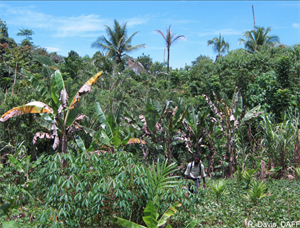There is no scientific name for the disease, the common name, Banana wilt-associated phytoplasma, BWAP, is used.
Phytoplasmas were first associated with banana wilt when plants with yellowing leaves were tested growing among coconuts showing signs of Bogia coconut syndrome in Madang Province, Papua New Guinea (see Fact Sheet no. 229). (Note, Bogia coconut syndrome is referred to as Cocos nucifera lethal yellowing phytoplasma in some publications.)
Molecular tests of the16S ribosomal protein gene (16Sr RNA) have shown that the same phytoplasma appears to be present in both banana and coconut (16SrIV-C) in the Madang area. Further, the phytoplasma is related to a coconut lethal yellowing phytoplasma recorded from Nigeria, associated with a disease known as Awka wilt. Later, in a taxonomic change, Atwa wilt phytoplasma was moved to the 16SrXXII-A group.
However, in other parts of Papua New Guinea (away from Madang) and in Solomon Islands where banana wilt-associated phytoplasma wilts occurs, other phytoplasmas have been identified: 16SrII, 16SrVIII and 16SrXXII-A in Papua New Guinea, and 16SrXXII-A and 16SrIV-A in Solomon Islands. Coconuts in the areas where they occur do not show disease associated with phytoplasma.





